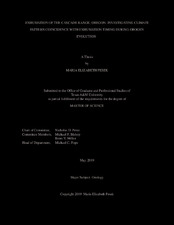| dc.description.abstract | Resolving the linkages among climate, erosion, and tectonics has implications for understanding geologic problems in deep time and in the future, yet studies yield conflicting results as to how surface and lithospheric processes drive mountain range development. The Cascade Range, NW USA is an ideal setting to assess how these drivers may guide rock uplift patterns, as structural and modern precipitation patterns have a unique along-strike spatial distribution. Orographic precipitation uniformly incises the western flank, broadly N-S compression in northern Oregon transitions to generally E-W extension in the south, and magmatism is segmented along the arc. New single-sample multi-proxy geo- and thermochronologic methods were applied at six sample locations along the Western Cascades range. At each location, a unique geologic relationship between incised Cenozoic plutons capped by basalts provides the opportunity to reconstruct the pluton exhumation pathway from crystallization to near-surface exposure and constrain the amount of rock uplift in this region. New and existing U-Pb geochronologic data reveal pluton crystallization ages between ∼10–24 Ma. Apatite (U-Th)/He ages reveal anomalously young cooling ages (∼2–4 Ma) near Mount Hood, which may reflect resetting by younger volcanic flows. Some apatite and zircon (U-Th)/He ages from southern Oregon are older than the corresponding zircon U-Pb crystallization age, which may be attributed to inclusions, zoning, or ^4He implantation. Remaining apatite and zircon (U-Th)/He ages range from ∼8–22 Ma and suggest a generally southward increase in cooling ages.^ 40Ar/ ^39Ar geochronologic results define the eruption age of basalts that unconformably overlie the plutons, which range from ∼5–8 Ma. Existing low-temperature apatite (U-Th)/He thermochronologic results from the Washington Cascades document uniform ∼6–12 Ma exhumation ages that were initially attributed to focused orographic precipitation and erosion. The diversity of ages in Oregon suggest the timing of exhumation occurred from ∼7–22 Ma, which differs from the results in Washington, and generally increases from north to south. These results are more consistent with processes that demonstrate along-strike variability, such as tectonics or magmatic processes, and support the interactions of climate, erosion, and tectonics in guiding orogen evolution. | en |


